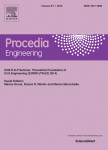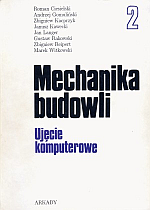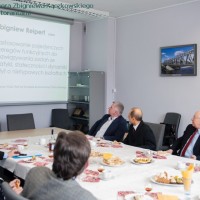| XXIII R-S-P Seminar, Theoretical Foundation of Civil Engineering (23RSP) (TFoCE 2014) |
 |
 |
 |
 XXIII R-S-P Seminar, Theoretical Foundation of Civil Engineering (23RSP) (TFoCE 2014) XXIII R-S-P Seminar, Theoretical Foundation of Civil Engineering (23RSP) (TFoCE 2014)Edited by Marian Drusa, Ruzica R. Nikolic and Marian Marschalko, Procedia Engineering, Volume 91, Pages 1-492 (2014) Isogeometric Analysis as a New FEM Formulation - Simple Problems of Steady State Thermal Analysis, Zbigniew Kacprzyk, Katarzyna Ostapska-Łuczkowska, Pages 87-92, doi:10.1016/j.proeng.2014.12.018 Read online>> Abstract: The subject of this article concerns Isogeometric Analysis as a new formulation within Finite Element Method. Motivation for this new approach was presented together with theoretical foundations of the method. The main subject of the paper is numerical implementation of the method in the Matlab environment. Special focus was put on the new concept of element and new geometry data interpretation in terms of analysis. Object oriented programming was utilized to produce more universal tool for future investigations. Several examples for Poisson's partial differential equation solution were presented. The h-refinement was utilized to show method convergence. Steady state thermal analysis was performed with temperatures and heat flux as boundary conditions. Quick geometry data transfer and mesh refinement from Rhino software with Grasshopper plug-in was also prepared and described in the paper. Finally, authors' conclusions concerning new method were presented and comparison between FEM and IGA was made on the basis of the studied examples. Keywords: Isogeometric Analysis (IGA); Finite Element Method (FEM); B-spline; NURBS; T-spline; CAD; Computer Aided Engineering ; Dynamics of Multi-body Mechanical Systems with Unilateral Constraints and Impacts, Artur Zbiciak, Zofia Kozyra, Pages 112-117, doi:10.1016/j.proeng.2014.12.024 Read online>> Abstract: The paper deals with mathematical description and computer simulation of multi-body dynamical systems with constraints imposed on displacements and velocities. Such mechanical systems contain a finite number of material points, whose motion is limited by unilateral constraints. The mathematical description of the problem, concerning the interaction between material points and unilateral constraints, is presented. The dynamic problem was defined in order to evaluate accelerations of elements and reactions of constraints. Moreover, the impact problem was formulated. The solution of the impact problem determines non-continuous change in velocities of elements and impulses of constraints' reactions. Keywords: dynamics; non-smooth mechanics; multi-body systems; unilateral constraints; impact; contact; non-linear vibrations ; Traditional Design versus BIM Based Design, Ireneusz Czmoch, Adam Pękala, Pages 210-215, doi:10.1016/j.proeng.2014.12.048 Read online>> Abstract:The paper shortly presents the history and development of the traditional design in civil engineering. Next, the idea of Building Information Modelling (BIM) and its practical benefits are described. Main part of the paper is devoted to discussion about what kind of difficulties we may encounter during the implementation of the BIM technology and how they are related to the potential benefits. Case study presents the existing design prepared in BIM technology. Keywords: traditional design; civil engineering; CAD; BIM Building Information Modelling – 4D Modelling Technology on the Example of the Reconstruction Stairwell, Zbigniew Kacprzyk, Tomasz Kępa, Pages 226-231, doi:10.1016/j.proeng.2014.12.051 Read online>> Abstract: Building Information Modelling (BIM) is a process that involves creating, generating, managing and using a digital representations of physical and functional characteristics of building. The use of the term 4D is intended to refer to the fourth dimension: time, i.e. 4D is 3D + schedule (time). The role of 4D BIM is to add a new dimension to 3D CAD or solid modelling—that is, 4D BIM adds a fourth dimension of Time to the 3D Space of CAD solid modelling on computer. In the paper show the project entirely made using 4D BIM Keywords: Building Information Modelling (BIM); 3D design; CAD; architectural engineering and construction (AEC) software |
Department seminars
No current events.
Conferences
No current events.
Selectable courses
Books

We have 39 guests online
Statistics
Content View Hits : 2997422Ostatnie seminaria
- 19-10-2022 | 12.15 T. Lewiński, Statyka i utrata stateczności prętów prostych, cd.
- 12-10-2022 | 12.15 T. Lewiński, Statyka i utrata stateczności prętów prostych
- 25-05-2022 | 12.00 M. Ostoja-Starzewski - Random Fields in Continuum Mechanics
- 09-03-2022 | 16.00 K. Bołbotowski - "Optymalne projektowanie membran"
- 27-10-2021 | 12.15 K. Józefiak "Modelowanie konstytutywnych właściwości gruntów jako podłoża betonowych ..."...
- 02-06-2021 | 08.30 B. Grzeszykowski "Wpływ rozwiązań materiałowo-konstrukcyjnych na ciągliwość ..."
- 19-05-2021 | 12.15 I. Wójcik-Grząba "Stateczność konstrukcji stalowych w świetle Eurokodu 3"
- 28-04-2021 | 10.15 S. Spodzieja "Wymiarowanie elementów ściskanych z uwzględnieniem wyboczenia ..."
- 20-01-2021 | 12.00 S. Dudziak "Program Dlubal RFEM. Zastosowanie do analizy zwichrzenia belek stalowych"



